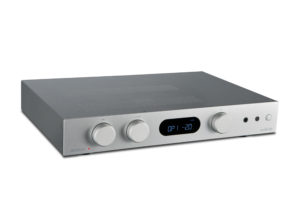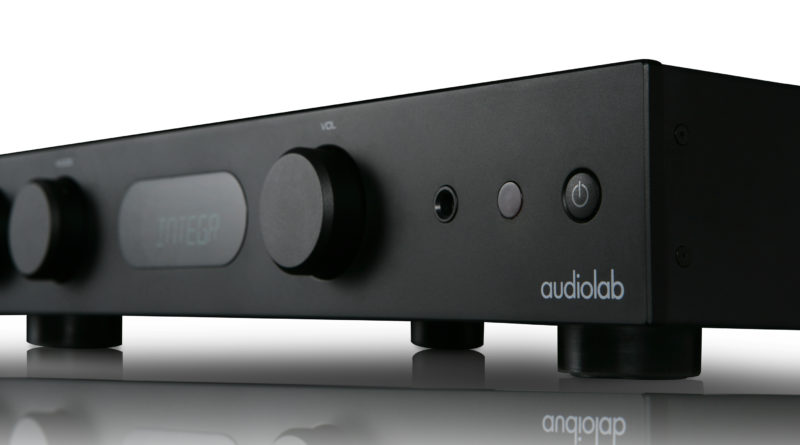AUDIOLAB 600A THE SOUND OF SCIENCE
Audiolab harnesses its latest tech to deliver an affordable integrated amplifier, fully equipped to meet the demands of modern music lovers – from vinyl records to digital streaming.
When Audiolab launched the iconic 8000A in 1983, it swiftly became Britain’s favourite ‘step-up’ from the budget amps of the time. Its crisp ergonomics, high-quality engineering, useful range of facilities and excellent all-round sound won it a legion of fans, cementing its place as one of the British hi-fi scene’s most significant products. Twenty-five years on and the company is set to repeat the feat: the new 6000A is the ideal amp for modern music lovers seeking premium-level performance, build quality and facilities at an affordable price.
An amplifier remains the beating heart of any high-performance audio system, but in 2018 a truly versatile integrated amp needs to cover many bases – digital and analogue sources, wireless connectivity for portable devices, a phono stage to cater for vinyl playback, amplification for headphones as well as speakers… That’s a lot to pack in, whilst keeping performance high and the price tag affordable – and yet, that’s exactly what the 6000A delivers. Outwardly, the 6000A bears strong resemblance to the 8300A – Audiolab’s existing, much-acclaimed integrated amplifier – with its rotary controls and large, central OLED display. But while the 8300A costs £899, the 6000A’s recommended price tag is just £599. What’s more, unlike its costlier, analogue-only sibling, it incorporates high-quality D/A conversion, enabling digital sources to be connected directly without an external DAC. It supplies four digital inputs, three line-level analogue inputs, an input for a turntable, wireless connectivity via Bluetooth and a dedicated headphone amp, in addition to its ability
when driving loudspeakers. That’s some roster for such an affordable amp.
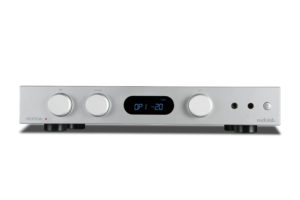
Classic Hi-Fi For The Modern Age
To incorporate all this functionality, there must be compromise under the lid, right? Wrong. The 6000A’s lead electronics designer is Jan Ertner – the same man responsible for the 8300A, as well as many other award-winning audio components over the years. When challenged to deliver 6000A at such a low price point, Jan returned to the technologies he implemented in the 8300A and painstakingly redeveloped them, whilst adding high-quality digital circuitry to the mix. The result is a new-generation amplifier evolved from the architecture of its pricier sibling, delivering exceptional sound quality alongside those flexible facilities.In many ways, then, the 6000A echoes the original 8000A concept from the early 1980s, rebooted for 2018 with the benefit of Audiolab’s latest technologies. When inflation is considered, it also happens to be the most inexpensive amplifier that Audiolab has ever produced.
Digital Circuitry
Much effort has been made to ensure the 6000A’s digital circuitry delivers the level of quality one might expect of a high-performance standalone DAC. As ever, Audiolab has turned to the ES9018 Sabre32 Reference chip family to perform D/A conversion, utilising ESS Technology’s 32-bit HyperStream architecture and Time Domain Jitter Eliminator to deliver ultra-low noise and high dynamic range.
No company knows more about making the most of this technically excellent, but challenging, DAC technology than Audiolab. If the circuitry that surrounds the ES9018 is not of sufficient standard, the resulting sound can seem a little cold and hard; treat it right, however, and the level of musical expression that this chip digs from the digital signal is captivating. Audiolab’s original, universally
acclaimed M-DAC was one of the first home audio components to incorporate an ES9018 chip back in 2011, and the company has been honing its implementation ever since.
One such critical element is the post-DAC active filter. Ertner and his team have paid great attention to this circuit, developing a Class A topology using op-amps that were specifically chosen for their synergy with the ES9018. The amp’s four S/PDIF digital inputs – two coaxial and two optical – handle hi-res PCM data up to 24-bit/192kHz and benefit from three user-selectable digital filters: ‘Fast Roll-Off’, ‘Slow Roll-Off’ and ‘Minimum Phase’. These settings allow the user to optimise the response to suit the source file and
bandwidth of the partnering equipment. Bluetooth connectivity, which includes support for the sonically superior aptX codec, allows easy wireless streaming from smartphones, tablets, laptops and more. Bluetooth-paired devices also benefit from the
quality of the amp’s DAC section and three digital filter options.
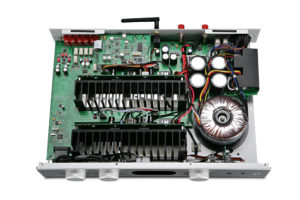
Analogue Circuitry
The 6000A’s discrete Class AB power amp stage delivers 50W per channel into eight ohms, with a maximum current delivery of 9 Amps into difficult loads. The output stage of the discrete power amp circuits uses a CFB (Complementary Feedback) topology, ensuring superior linearity and excellent thermal stability, as the idle current is kept independent of the temperature of the output transistors. A substantial 200VA toroidal transformer, followed by 4x15000uF reservoir capacity (60000uF in total), helps the amp to maintain firm control of the music whilst enabling excellent dynamic range. The preamp section is kept as simple as possible to maintain signal purity, with line input signals passing to a precision analogue volume stage. The latter covers the range from -80dB to +8dB in steps of 2dB and
1dB (step resolution increases with volume position). Much effort has gone into the physical layout of the 6000A’s circuitry, protecting the sensitive preamp section from noise interference. This, plus the use of independent low-noise power supplies for critical stages, helps to deliver a performance that rivals significantly more expensive analogue amplifiers, even before taking the 6000A’s impressive digital
circuitry into account.
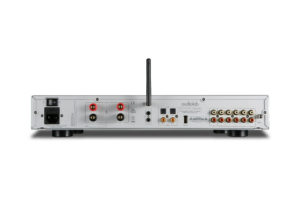
Turntables & Headphones
In recognition of the recent vinyl revival, Audiolab has included a phono stage for moving magnet phono cartridges – a high-quality, low-noise, JFET-based circuit with precise RIAA equalisation. Similarly, an increasing number of people are using headphones for music listening, so Audiolab has incorporated a dedicated headphone amp with current-feedback circuitry. Its gain bandwidth and high slew rate ensure a dynamic, detailed and engaging performance with all manner of headphone types – more boxes ticked for this most integrated of integrated amplifiers.
Operational Modes
The 6000A’s flexibility with digital and analogue sources is not the only thing that makes it so versatile; it also offers three distinct operational modes, reflecting the amp’s discrete internal architecture and enabling it to adapt to its user’s evolving requirements.
The primary mode is ‘Integrated’ – this combines the pre and power amp stages, for the connection of digital and analogue sources to the amp’s inputs and a pair of speakers to its binding posts. ‘Pre-Power Mode’ disconnects the pre and power amp stages. The allows the 6000A to be used solely as a power amp – for example, connected to an AV processor in a home cinema system. It also enables
additional signal processing to be added, by connecting the 6000A’s ‘preamp out’ socket to an external processor, then returning the processor’s output to the amp’s ‘power amp in’ socket. Finally, ‘Pre Mode’ disables the power amp stage, turning the 6000A into a standalone preamp. This enables external power amplification to be added, thus providing a possible upgrade path.
Flexibility Without Compromise
Jan Ertner, the project’s lead electronics designer, commented: “The majority of audio components that I design retail for upwards of £1,000, so the 6000A was a tremendous challenge – an integrated amp with a full roster of digital and analogue facilities at a target retail price of just £600. What’s more, it had to deliver the excellent sound quality for which Audiolab is famed, without compromising one aspect of performance in order to accommodate another. “I’m proud of the results we have attained. On DAC performance alone, the 6000A will match standalone DACs in the £500-£600 range. As for the analogue pre and power amp stages, we’ve worked long and hard to ensure that the 6000A delivers class-leading sound quality. As a package – a high-quality, affordable integrated amp for the modern age – the 6000A represents excellent value-for-money.” The 6000A delivers remarkable sonic consistency, whatever the user connects to it. Its sound is musically engaging, yet also refined. The soundstage it produces is broad and deep, with crisply defined detail revealing the character of voices and instruments. Impressive dynamic range conveys natural impact, while the amp’s transient ability keeps feet tapping with rhythmic music. Deep, well-defined bass, expressive midrange and sweet, subtle treble – the 6000A delivers an adroitly balanced performance with all kinds of music, from rock and electronica to classical and jazz. In short, it delivers an open window on the music being played, as all great hi-fi should, engaging the listener with natural, unforced energy that is fully reflective of the source material.
Audiolab firmly believes the 6000A is the best-value amplifier the company has ever produced. It is available from October in a choice of silver or black, at an RRP of £599.
Specification summary
• Integrated amplifier with DAC
• Class AB power amplification: 2x50W into 8 ohms; 2x75W into 4 ohms
• aptX Bluetooth streaming
• ESS Technology Sabre32 Reference DAC
• Three user-selectable digital filters
• Class A post-DAC active filter
• Low noise JFET MM phono stage
• Dedicated current-feedback headphone amp
• Three operational modes: Integrated Mode; Pre-Power Mode; Pre Mode
Cable inputs
• 4x S/PDIF digital audio (2x optical; 2x coaxial)
• 4x analogue audio (3x line level; 1x MM phono)
• Power amp input
• USB for firmware updates
• 12V trigger
Cable outputs
• Speaker binding posts
• Headphone output
• Preamp output
• 12V trigger
Formed in the early 1980s by Philip Swift and Derek Scotland, Audiolab earned worldwide acclaim with the 8000A – an integrated stereo amplifier that became a classic ‘step-up’ from the budget models of the time. Now part of the IAG brand family, Audiolab’s recent fame is largely derived from its hugely respected DAC circuitry, earning the company a plethora of awards since the launch of the 8200CD and M-DAC in 2010 and 2011 respectively. Today, the company continues to make highly acclaimed source and amp components – delivering crisp, clean ergonomics and sensational sound with everything from vinyl to the latest digital formats – as well as a range of high-performance in-ear monitors.
www.audiolab.co.uk
